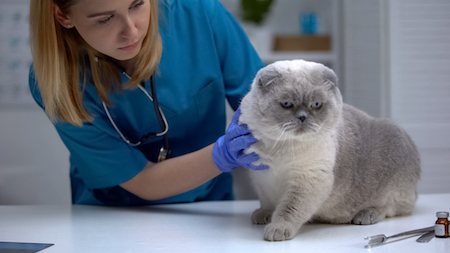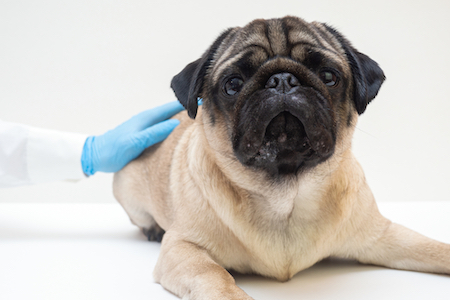Pet Insurance Review > Pet Wellness Guides > FAS in Pets at Veterinary Clinics - Pet Insurance Review
FAS in Pets at Veterinary Clinics
Posted: 08/09/2022 | BY: Erin Cain | Categories: Behavior , Cat , Dog , Pet care , Vets
When visiting a veterinary clinic, thousands of pets experience fear, anxiety, and stress, also called FAS. This condition can lead to serious behavioral problems, such as pets refusing to eat or drink, urinating or defecating inappropriately, or even biting people and acting out aggressively. Let’s discuss the signs of FAS in pets, how to deal with it, and what you can do to make your pet’s visit to the veterinarian clinic less stressful.

What is FAS in pets?
Many pet owners believe their dogs and cats dislike and fear regular veterinary visits, so they don’t bring them as often as they should. Unfortunately, without regular veterinary examinations, a vet won’t find the early signs of illness and disease in a pet in time to treat the issue. The veterinary behavior community has acknowledged that cats and dogs experience fear, anxiety, and stress (FAS) when visiting the veterinary clinic. Many clinics have gone out of their way to make the clinic as pet-friendly and calming as possible.
FAS may occur in several phases before and throughout the veterinary visit. For example, some pets experience FAS during travel from home to the veterinary clinic. The pet doesn’t even get to the veterinary clinic until FAS begins to impact them negatively. Some dogs and cats have learned that all they get in the car for is a veterinary visit. They instantly associate a car ride with a frightening experience at the vet clinic.

How does FAS impact pets?
Research shows that FAS interferes with pets’ recovery, contributes to long-term health issues, and makes therapy difficult. Physiologic and behavioral changes associated with fear and anxiety are triggered following a stressful event. The following FAS triggering stressors are encountered during veterinary visits:
- humidity
- odors
- noise
- pheromones
- pain
- hunger and thirst
- disease
- being handled by strangers
- being separated from human family members.
The body’s attempt to handle a situation it feels unprepared for is called the stress response, or the “flight or fight” response. Although the threat may be either real or perceived, it causes a stress response regardless.

How can you recognize FAS in pets?
Two phases may characterize an immediate stress response in a dog with FAS: immediate signs that appear suddenly and delayed signs that occur later.
The signs of a pet’s stress response can include:
- panting
- fear-based aggression
- increased heart rate
- physical preparation of a “fight or flight” response
- decreased ability to feel pain
- memory consolidation (may reappear as PTSD at future visits)
- decreased rational thinking
Chronically elevated cortisol levels can affect various body systems, resulting in symptoms of a delayed stress response. The affected body systems include:
- Skin
- Poor hair growth
- Thinning fur
- Musculoskeletal system
- chronic fatigue
- muscle wasting
- Gastrointestinal system
- diarrhea
- inflammatory bowel disease (IBD)
- ulcers
- Immune system
- delayed healing

What are the other effects of FAS on pets?
A veterinary visit is where FAS creates problems. These pets are harder to examine, which may prevent the veterinary healthcare team from diagnosing them comprehensively. A FAS pet may injure a veterinary healthcare team member because of its aggressive behavior. Some of the immediate outcomes of FAS may make pets needing sedation or anesthesia require higher doses of medication, potentially causing them more harm. It will take longer for dogs with FAS who must undergo surgery, and those hospitalized due to illness will take longer to recover.
In particular, the long-term consequences of FAS are dire for dogs. For example, dogs with FAS may lose their basic training due to how fear impacts learned behavior. Even the most highly trained dogs may experience this loss due to what occurs in the brain’s emotional center. The vet visit and fear are linked in the dog’s mind, evoking vivid sensory memories. Dogs with PTSD have an all too easy time recalling fearful memories.

How can a FAS pet be helped?
You can do many things to make a FAS-free veterinary visit for your pet. Before your pet leaves your house to see the vet, you can condition him to enjoy traveling in the car and help him avoid associating car rides with bad things. Your veterinarian can suggest how to help your pet adjust to car rides.
Once you arrive at your vet clinic, the team will assist in making sure your dog has a FAS-free experience. Every pet is unique, so your vet will advise handling the examination and visit. Your veterinarian may suggest swaddling or the need for a sedative. Your veterinary care team will determine the procedure with you and your family. With your veterinarian’s help, you can help reduce and even eliminate FAS from your pet’s appointments.
Take the worry out of vet visits with a pet insurance plan.
With a pet insurance plan, you can focus on helping your dog or cat through their veterinary examination rather than worrying about the costs. Let Pet Insurance Review find the best pet insurance policies for your pet’s needs and your budget. Get a free quote for your pet today!
References:
- MSPCA-Angell. (2022). What is the Fear Free concept in Veterinary Medicine? Retrieved from https://www.mspca.org/angell_services/fear-free-concept/
- Belmont Animal Hospital. (2022). How Chronic Fear, Anxiety, and Stress Affect Your Pet’s Health. Retrieved from https://www.belmontanimalhospital.com/2019/12/19/how-chronic-fear-anxiety-and-stress-affect-your-pets-health/
- Lensen, R., Moons, C., Diedrich, C. (2019). Physiological stress reactivity related to behavioral traits in dogs. Retrieved from https://www.ncbi.nlm.nih.gov/pmc/articles/PMC6748563/
- Madson, C. (2022). Preventing and Treating Travel Anxiety in Dogs. Retrieved from https://www.preventivevet.com/dogs/preventing-travel-anxiety-and-carsickness-in-dogs
- Dodson, N. (2016). Canine PTSD. Retrieved from https://www.psychologytoday.com/us/blog/dog-days/201610/canine-ptsd
Disclaimer
The information contained on this blog is intended for informational and educational purposes only and should not be construed as medical advice. It is not a substitute for professional veterinary care. Always consult with your veterinarian before making any changes to your pet's health care or treatment plan.
The authors of this blog are not veterinarians and do not claim to be experts in pet health. The information provided here is based on our own experiences and research, as well as information from reputable sources. However, we cannot guarantee the accuracy or completeness of this information.
We encourage you to do your own research and consult with your veterinarian before making any decisions about your pet's health.